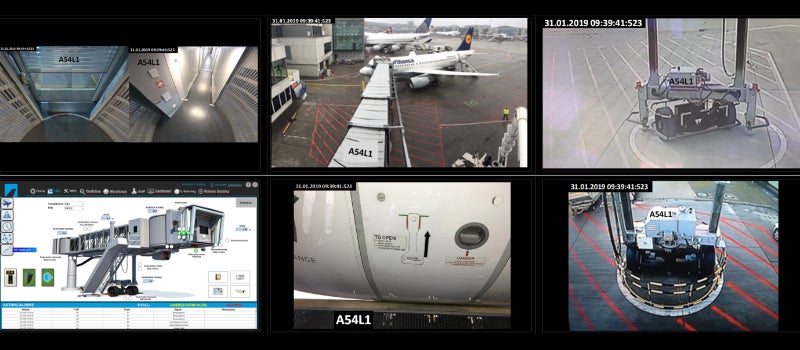

Centralised and automatic driving technology is step by step reachable and being introduced at airports with the remote control of the passenger boarding bridges (PBBs) from a centralised control room.
We have developed a full remote-control system solution that allows, through specific interfaces with the PBBs, for a complete and secure remote operation, reducing accidents and optimising turnaround times.
Taking into consideration the huge number of different types of passenger boarding bridges and manufacturers, our solution is unique as it can be installed and adapted to all of them. This is a great achievement and a very big innovation because it helps to standardise PBB operations while ensuring secure communication.
The remote operation comprises the total PBB movement, including full docking manoeuvre from the parking position to the ultimate contact with the aircraft, and full undocking movement from the docked aircraft back to the parking position. The trained operator is always in control of the PBB, but they can also decide to manoeuvre it via automatic pre-programmed routes, which eases overall operation.
As variations to the standard remote control, our solution includes automatic pre-positioning, automatic undocking from the aircraft to the parking position, automatic communication with the Docking Guidance Systems and CCTVs to ensure the incoming aircraft is the right one according to the AODB and is correctly parked in its position.
With one single remote control position all the PBBs at the airport can be monitored and controlled, allowing for the operator to switch from one stand to another one in the far end of the airport with just a click of the mouse, thus making sure that the operations start on-time, and that no hastes, vehicle movements or transport means were needed. This greatly reduces apron accidents involving transfer vehicles, staff movement around aircraft and an overall CO₂ emissions reduction due to fewer vehicles required.
Our solution is directly linked to the real-time monitoring and maintenance applications, meaning that before the operator takes control of the PBB, the system has automatically performed a pre-check of all gate equipment functionalities, communications and information coming from the AODB and FIDS to exactly determine and release this PBB for operation. This means that there is no room for unexpected error messages from the PBB resulting in a delayed departure or arrival aircraft.
This automatic synchronisation with the operational and maintenance departments optimises the overall turnaround times, and by so doing, enhances the passenger experience, but it also helps the reporting and analysing of all performed operations. And it is precisely this full management control that enables our solution to be interlinked with an Airport Operational Control Center (AOCC), where required management and strategic decisions can be taken and implemented in real-time.

